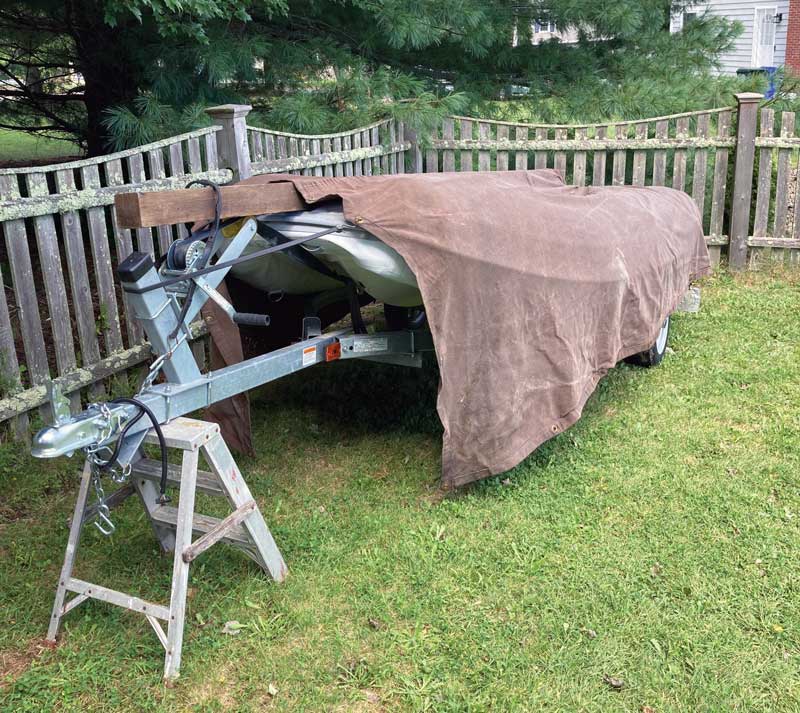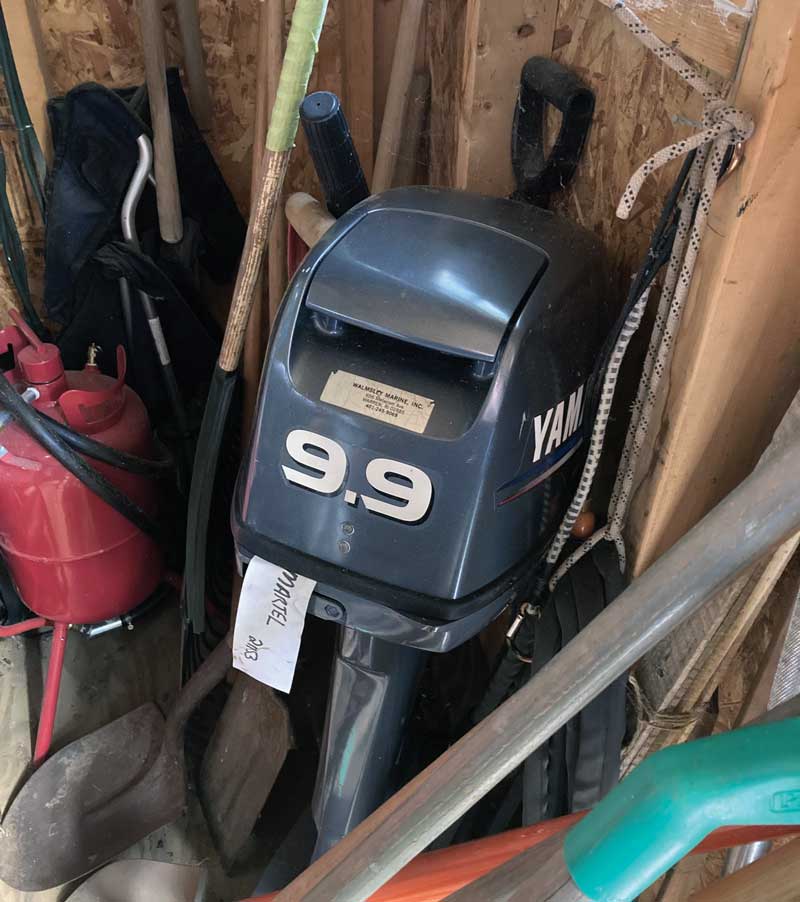Summer is officially over, and every year it seems to fly by faster and faster! It’s once again time to (regrettably) put the boat away for the winter, to winterize the engine, and cover her over until spring. For many, winterizing their boat has become fairly repetitive; we do it every year, and there are comprehensive and helpful guidelines and winterization checklists available from reliable sources, including BoatUS, for example. If your boat is cared for and regularly serviced by a long-established boatyard, that yard will have many of its own procedures and recommended checklists in place and will take care of those details for you.

Those checklists are great, but let’s take a moment to talk about a few of the other things that may also be important to consider when putting your powerboat away for the season. People engage in different practices that vary often by region. I learned a few things this year during some of my travels south while ‘scouting’ for a new boat.
A broker whom I spoke to in a boat town in Tidewater Virginia, told me that most boat owners today don’t opt to shrink-wrap their boats anymore due to the expense and the amount of plastic waste generated that must be disposed of. They will instead opt for a tarp or fitted canvas cover that can be reused again for several years, rather than the one-time use for shrinkwrap. In many cases, for boats stored in boatyards south of the snow line (wherever that may be), boat owners with low-maintenance surfaces may opt for no cover at all; the only issue will be sun and UV radiation that will oxidize gelcoat and painted surfaces and degrade non-skid decking. There are a number of products that can be applied to a boat that will protect against UV degradation, but they must be applied every three to five weeks, according to one manufacturer. 303 Products is one popular label, providing a spray-on DIY product labeled “Aerospace Protectant,” and there are others; simply spray on and wipe off any excess. This is especially helpful for protecting inflatable dinghies; I use it on my RIB.
The advantage to covering a boat with canvas is that it will protect a boat from water getting in at the deck level over the course of the winter and causing problems. I’ve seen water get into a deck, particularly around deck hardware and fittings, aided by the temperature fluctuations over the winter months, even if you don’t have snow or ice on your boat. Deck hardware can be subject to stresses that will allow water to creep in over time. A moisture meter can identify the problem of moisture getting into deck and gunwale laminates, and it’s a sad discovery because it means an expensive repair. If the water in the laminate should freeze, then you will have an even more serious problem with delamination and structural weakening. So, although it is a task to canvas-cover a boat over the winter season if it is stored outside, the protection against the elements is arguably well worth the hassle of covering to prevent potential problems later on.

There are a number of storage options, of course. The most common choice is a boatyard or marina. Storing your boat ‘on the hard’ allows thorough inspection of the bottom and power washing, as well as installing fresh zinc anodes, cleaning out through-hull fittings, coating propellers and shafts with spray antifouling (zinc compounds), painting, and careful examination of the hull for any damage that may have occurred during the season. Working with a yard or marina may also make available the talents of engine mechanics and yard personnel who can help winterize the freshwater system with non-toxic antifreeze. You’ll also want to make sure that you drain the water tank(s) and water heater, and fully charge the starter and house batteries. Nowadays, unless you winter in a yard in northern New England, there is no need to remove your batteries; just make sure that they are fully charged.
In more southern waters, you may be able to keep your boat in a slip at a marina, one where there is little danger of ice forming. In New England waters, ‘bubble skirts’ discourage the formation of ice around the hull, hardly a concern in the lower Chesapeake. Recently, I traveled to charming Deltaville, VA, to look at a boat that I had interest in. While there I noted, once again, the presence of boat dock roofs, a type of structure that we don’t see very much in northern waters. With a boat dock roof, the boat is accessible and usable practically all year ‘round, while being solidly protected from the effects of the brutal sun, as well as from precipitation. But protection from above does not include protection from below. My broker-friend in Deltaville informed me that the water there is somewhat brackish, and there is still plenty of marine growth including grass and barnacles in those waters. A boat docked there needs hauling once a season for bottom cleaning and attention to the other items mentioned earlier, i.e., zincs, mussels, or growth inside through-hull ports, and more. The propeller might need cleaning and attention two to three times during the course of the season, especially if the boat doesn’t go out much.
Of course, owners who plan to keep their boats in a slip year-round also need to be aware of the electrical characteristics of the waters around them. Electrolysis from stray currents can eat up zincs and other metals quickly in a crowded harbor or marina. The more crowded the marina, the more significant the concern for damage from electrolysis. I used to hang a solid zinc ‘guppy’ over the side of my boat when it was on its mooring and I wasn’t using it, because the harbor was notorious for electrolysis issues. The ‘guppy’-shaped anode was attached to a cable, which in turn fed below through a port and clipped onto the block of my engine. I would simply reel it in and stow it whenever I took the boat out for the weekend. In this way, I protected my propeller and other metals below my boat’s waterline, including the other zincs.

If your boat is practically trailerable, of course, you can simply bring it home and store it on your property like I do with my 10-foot inflatable RIB. It spends all summer high and dry on a dinghy float down at the boat club, and in the fall hops up onto its trailer to come home. On the way home, I stop at Stanley’s Boatyard to drop off my Old Faithful 9.9-hp two-stroke outboard. I leave it with them for winterization, and they do a good job of it every year. In a few weeks they will call me to come pick it up to take home where it will wait out the remainder of the off season in my dry backyard shed. Once the RIB is home and tucked into the backyard, similar rules apply; I block the trailer wheels, unhook the trailer, remove the drain plug, and give the bladders a coat of 303, then cover the boat with a canvas tarp for the winter. A three-inch by three-inch by 12-foot oak beam serves as a ridgepole so that the canvas can drain properly without sagging if there is snow. Drain and discard the old mixed gasoline in the tank; never carry it forward to the next year. I deflate the RIB’s bladders somewhat to ease pressure on them, but I keep them mostly ‘soft’ inflated so that they will retain shape over the winter and after all, support the canvas cover.
These are just a few of the tips and tricks that I have learned over the years when preparing my boat (and dinghy) for the off season.
By Captain Michael L. Martel
Think Before You Shrink
The Maryland Department of Natural Resources (DNR) is encouraging boaters to try a reusable cover or “go bare” this year. According to the DNR, semi-custom covers cost the same as shrink-wrapping boats around 30 feet for two seasons and can last five to 10 years. Canvas shops can repair and clean reusable boat covers which extends their life even further. If you opt to skip a covering completely and go bare, the DNR recommends deep cleaning your boat the following spring (for DIY cleaning tips, visit dnr.maryland.gov/boating/Documents/ts1vesselm.pdf).
While shrinkwrap does a great job keeping boats clean and protected, it also is a single use plastic that generates tons of waste. To learn more about shrinkwrap recycling, visit the shrinkwrap page on the Maryland DNR website.